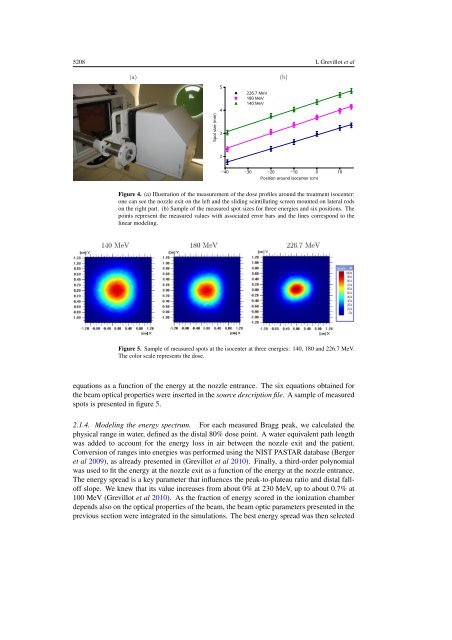A Monte Carlo pencil beam scanning model for proton ... - Creatis
A Monte Carlo pencil beam scanning model for proton ... - Creatis
A Monte Carlo pencil beam scanning model for proton ... - Creatis
Create successful ePaper yourself
Turn your PDF publications into a flip-book with our unique Google optimized e-Paper software.
5208 L Grevillot et al<br />
(a) (b)<br />
Figure 4. (a) Illustration of the measurement of the dose profiles around the treatment isocenter:<br />
one can see the nozzle exit on the left and the sliding scintillating screen mounted on lateral rods<br />
on the right part. (b) Sample of the measured spot sizes <strong>for</strong> three energies and six positions. The<br />
points represent the measured values with associated error bars and the lines correspond to the<br />
linear <strong>model</strong>ing.<br />
Figure 5. Sample of measured spots at the isocenter at three energies: 140, 180 and 226.7 MeV.<br />
The color scale represents the dose.<br />
equations as a function of the energy at the nozzle entrance. The six equations obtained <strong>for</strong><br />
the <strong>beam</strong> optical properties were inserted in the source description file. A sample of measured<br />
spots is presented in figure 5.<br />
2.1.4. Modeling the energy spectrum. For each measured Bragg peak, we calculated the<br />
physical range in water, defined as the distal 80% dose point. A water equivalent path length<br />
was added to account <strong>for</strong> the energy loss in air between the nozzle exit and the patient.<br />
Conversion of ranges into energies was per<strong>for</strong>med using the NIST PASTAR database (Berger<br />
et al 2009), as already presented in (Grevillot et al 2010). Finally, a third-order polynomial<br />
was used to fit the energy at the nozzle exit as a function of the energy at the nozzle entrance.<br />
The energy spread is a key parameter that influences the peak-to-plateau ratio and distal falloff<br />
slope. We knew that its value increases from about 0% at 230 MeV, up to about 0.7% at<br />
100 MeV (Grevillot et al 2010). As the fraction of energy scored in the ionization chamber<br />
depends also on the optical properties of the <strong>beam</strong>, the <strong>beam</strong> optic parameters presented in the<br />
previous section were integrated in the simulations. The best energy spread was then selected







